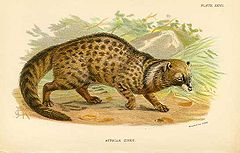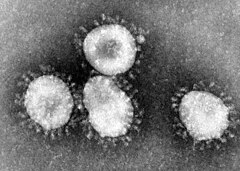Civet: Difference between revisions
m update fr: |
|||
| Line 32: | Line 32: | ||
==Taxonomy== |
==Taxonomy== |
||
that cat I'd gonna rip yo face off fo |
|||
The common name is used for a variety of [[Carnivora|carnivorous]] mammalian species, mostly of the [[family (biology)|family]] [[Viverridae]] (although it resembles the other civets, the [[African Palm Civet]] (Nandinia binotata) is genetically distinct and belongs in its own monotypic family, [[Nandiniidae]]). |
|||
In 2005, the [[World Wide Fund for Nature]] released photos taken by a night time camera trap of an unknown [[carnivore]] (nicknamed the [[cat-fox]]) on [[Borneo]]. Scientists debate whether this animal is new species of civet, or a known, but rare, species (such as [[Hose's Palm Civet]], thought previously to be extinct). |
|||
==Physical characteristics== |
==Physical characteristics== |
||
Revision as of 02:15, 29 March 2010
| Civets | |
|---|---|

| |
| African Civet, Civettictis civetta | |
| Scientific classification | |
| Kingdom: | |
| Phylum: | |
| Class: | |
| Order: | |
| Family: | in part
|
| Genera | |
Civets are small, lithe-bodied, mostly arboreal mammals native to the tropics of Africa and Asia. Civet may also refer to the distinctive musk produced by the animal.
Taxonomy
that cat I'd gonna rip yo face off fo
Physical characteristics
Civets have a broadly cat-like general appearance, though the muzzle is extended and often pointed, rather like an otter or a mongoose. They range in length from about 17 to 28 in (43 to 71 cm) (excluding their long tails) and in weight from about 3 to 10 lb (1.4 to 4.5 kg).
The civet produces a musk (also called civet) highly valued as a fragrance and stabilizing agent for perfume. Both male and female civets produce the strong-smelling secretion, which is produced by the civet's perineal glands. It is harvested by either killing the animal and removing the glands, or by scraping the secretions from the glands of a live animal. The latter is the preferred method today.
Animal rights groups, such as the World Society for the Protection of Animals, express concern that harvesting musk is cruel to animals. Between these ethical concerns and the availability of synthetic substitutes, the practice of raising civets for musk is dying out. Chanel, maker of the popular perfume Chanel No. 5, claims that natural civet has been replaced with a synthetic substitute since 1998.[1]
Habitat

Viverrids are native to Africa (except the area immediately south of the Mediterranean), Madagascar, the Iberian Peninsula, southern China, and Southeast Asia. Favoured habitats include woodland, savanna, and mountain biomes and, above all, tropical rainforest. In consequence, many are faced with severe loss of habitat; several species are considered vulnerable and the Otter Civet is classified as endangered.
Sri Lanka
In Sri Lanka, the Asian palm civet species is known as "Uguduwa" by the Sinhala speaking community. The terms Uguduwa and Kalawedda are used interchangeably by the Sri Lankan community to refer to the same animal. However, the term Kalawedda is mostly used to refer to another species in the civet family, the Small Indian Civet. Sri Lanka also has an endemic civet species called Golden Palm Civet.
Exotic Dung Coffee
Kopi Luwak, also known as caphe cut chon (fox-dung coffee) in Vietnam and kape alamid in the Philippines, is coffee that is prepared using coffee cherries that have been eaten and partially digested by the Asian Palm Civet, then harvested from its feces.[2]
SARS

There has been some speculation that the source of the SARS-CoV virus, which had a significant outbreak in Asia in 2003, can be traced back to a particular species of civet, the Masked Palm Civet.[3] Many people hunt the Masked Palm Civet for its meat, and due to this, there are those who believe that these practices may have introduced the SARS virus to humans, though the WHO states that more research must be conducted before any conclusion linking the animals to the virus can be drawn.[4]
While the virus was confirmed present in the fecal and respiratory specimens taken from Masked Palm Civets, investigators have recently recognized civets as incidental, versus reservoir hosts. A more likely hypothesis now appears to be that the virus was contracted in some other animal. The most likely original host species are bats closely related to the Chinese horseshoe-nosed bats, which then infected the Masked Palm Civet.
After the conjecture of the infection being hosted by civets was made public, the ingestion of wild animals in Asia has dropped drastically. The percentage of people who consumed wild animals was previously around 49%, but has since dropped to approximately 38%.[5]
Yi Guan of Hong Kong University isolated the SARS virus and recommended the slaughter of captive civets in the area during a resurgence of SARS in late 2003. This is credited with potentially preventing the spread of the infection.[6]
References
- ^ http://www.straightdope.com/columns/read/2306/does-civet-come-from-tortured-cats
- ^ Brewed Coffee: Civet Coffee, 30 November 2006, retrieved 2009-05-25
- ^ Calisher, Charles H. et al. "Bats Prove To Be Rich Reservoirs for Emerging Viruses." Microbe (American Society of Microbiology). Vol. 3, No. 11, 2008, p. 526. 6 January 2009.
- ^ http://www.who.int/csr/don/2003_05_23b/en/
- ^ Press, Associated. "Civets, Other Wildlife Off the Chinese Menu." MSNBC. 18 April 2008. 6 July 2008 <http://www.msnbc.msn.com/id/12371160/>.
- ^ Science Magazine. "Exclusive: SARS Sleuth Tracks Swine Flu, Attacks WHO." Science Magazine. 4 May 2009. <http://blogs.sciencemag.org/scienceinsider/2009/05/exclusive-meet.html>
External links
- Raising Small Indian civet (Viverricula indica) website www.vietlinh.vn
